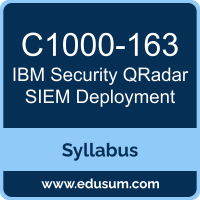 Use this quick start guide to collect all the information about IBM Security QRadar SIEM Deployment (C1000-163) Certification exam. This study guide provides a list of objectives and resources that will help you prepare for items on the C1000-163 IBM Security QRadar SIEM V7.5 Deployment exam. The Sample Questions will help you identify the type and difficulty level of the questions and the Practice Exams will make you familiar with the format and environment of an exam. You should refer this guide carefully before attempting your actual IBM Security QRadar SIEM Deployment certification exam.
Use this quick start guide to collect all the information about IBM Security QRadar SIEM Deployment (C1000-163) Certification exam. This study guide provides a list of objectives and resources that will help you prepare for items on the C1000-163 IBM Security QRadar SIEM V7.5 Deployment exam. The Sample Questions will help you identify the type and difficulty level of the questions and the Practice Exams will make you familiar with the format and environment of an exam. You should refer this guide carefully before attempting your actual IBM Security QRadar SIEM Deployment certification exam.
The IBM Security QRadar SIEM Deployment certification is mainly targeted to those candidates who want to build their career in IBM Security domain. The IBM Certified Deployment Professional - Security QRadar SIEM V7.5 exam verifies that the candidate possesses the fundamental knowledge and proven skills in the area of IBM Security QRadar SIEM Deployment.
IBM Security QRadar SIEM Deployment Exam Summary:
| Exam Name | IBM Certified Deployment Professional - Security QRadar SIEM V7.5 |
| Exam Code | C1000-163 |
| Exam Price | $200 (USD) |
| Duration | 90 mins |
| Number of Questions | 63 |
| Passing Score | 67% |
| Books / Training |
IBM Certified Deployment Professional - QRadar SIEM V7.5 - Exam C1000-163 Preparation Guide QRadar SIEM Administrator |
| Schedule Exam | Pearson VUE |
| Sample Questions | IBM Security QRadar SIEM Deployment Sample Questions |
| Practice Exam | IBM C1000-163 Certification Practice Exam |
IBM C1000-163 Exam Syllabus Topics:
| Topic | Details | Weights |
|---|---|---|
| Deployment Objectives and Use Cases |
- In this initial task, the QRadar deployment specialist, together with the client, analyze and document the business drivers and use cases that the deployment should address. Based on detailed use cases, the deployment specialist can develop the appropriate deployment architecture.
|
10% |
| Architecture and Sizing |
- Defining and documenting the deployment architecture creates the underlying basis for successfully installing QRadar. The architecture defines a clear scope of the project based on the use cases. Here, the deployment specialist designs the solution and required components, such as the individual QRadar appliances (physical or virtual). The architecture also addresses topics such as high availability and disaster recovery, data retention, and licensing.
|
16% |
| Installation and Configuration |
- Based on the architecture documentation and scope, the deployment specialist installs and configures the QRadar components.
|
16% |
| Event and Flow Integration |
- After all QRadar components have been successfully deployed, it is time to add and configure the organization's log and flow sources. This includes automatically discovered and manually configured log sources as well as any custom properties or content extensions to satisfy the client's use cases.
|
13% |
| Environment and X-Force Integration |
- The deployment specialist configures the included QRadar apps to function properly within the organization's environment as well as setting up the IBM X-Force Threat Intelligence Feeds. The deployment specialist also leads the client to properly populate and use the asset database (to the extent that has been identified in the use cases and scope of the project).
|
6% |
| System Performance and Troubleshooting |
- The deployment specialist performs initial system performance and troubleshooting, demonstrating the use of appropriate tools to perform these tasks. This does not entail ongoing support but is focused on the scope defined in the project objectives and architecture.
|
13% |
| Initial Offense Tuning |
- As defined in the scope, project objectives and architecture, the deployment specialist performs initial tuning of offenses and guides the client on how to best approach this task going forward.
|
10% |
| Migration and Upgrades |
- In case the project objectives and scope contain QRadar migration and/or upgrades, the deployment specialist has to investigate several migrations or upgrade related topics, such as data and content migration, app framework use cases, and other upgrade prerequisites.
|
10% |
| Multi-Tenancy Considerations |
- The deployment specialist needs to be skilled to support an organization that needs to implement a QRadar multi-tenant deployment.
|
6% |
To ensure success in IBM Security QRadar SIEM Deployment certification exam, we recommend authorized training course, practice test and hands-on experience to prepare for IBM Security QRadar SIEM V7.5 Deployment (C1000-163) exam.
